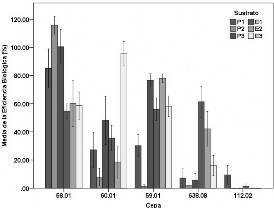Evaluation of the production of fruiting bodies of the
DOI:
https://doi.org/10.36829/63CTS.v1i1.8Abstract
This study determined the production of fruiting bodies of five native strains of Agrocybe cylindracea over three different substrates and two heat treatments, by the biological efficiency percentage and the measurement of diameters of pileus. The major percentage of biological efficiency found from the strains in the evaluated substrates was 115.84%, and corresponded to the substrate formulated by 29% of wheat straw and 1% of pasteurized soy flour, and obtained from the strain 58.01, which also produced the major biological efficiencies in all of the evaluated substrates. When confronting the percentage of biological efficiency in the different substrates, all the strains presented high values in the substrate comprising 28% of wheat straw, 1% of soy flour, and CaCO3. In relation to the diameter of the fruiting bodies, the strains 58.01, 59.01, 60.01, and 638.08 produced pileus less than 2 cm, between 2-4 cm and greater than 4 cm in the different substrates and treatments, excepting the strain 59.01 which in the substrate formulated with 29% of wheat straw and 1% of soy flour, only produced fruiting bodies with pileus less than 2 cm and between 2-4 cm. In the chemical proximate analysis of the fruiting bodies of the tested strains, a high percentage of proteins, crude fiber, and carbohydrates was obtained, and also a low percentage of fats.
Downloads
References
Andrade, C. (2007). Descripción de las características de cultivo in vitro de cepas nativas de Agrocybe aegerita (Brigant) Singer. (Tesis de graduación: Química Bióloga) Universidad de San Carlos de Guatemala, Facultad de Ciencias Químicas y Farmacia, Guatemala.
Bateman J. (1970). Nutrición animal. Manual de mé- todos analíticos. México D.F: Centro Regional de Ayuda Técnica.
Bran, M., Morales, O., Cáceres, R. y Flores, R. (2003a). Contribución al conocimiento de los hongos comestibles de Guatemala. Revista Científica, 1(1), 2-24.
Bran, M., Morales, O., Cáceres. R., y Flores, R. (2003b). Hongos comestibles de Guatemala: Diversidad, cultivo y nomenclatura vernácula. (Fase III). (Inf-2003-30). Universidad de San Carlos de Guatemala, Dirección General de Investigación, Guatemala.
Bran, M., Morales, O., Flores, R., Cáceres, R. y Gurriarán, N. (2009). Cultivo de cepas guatemaltecas del hongo comestible Tx'yol B'aqman (Agrocybe cylindracea (DC.) Maire): caracterización y producción de cuerpos fructíferos. (Inf-2009-45). Universidad de San Carlos de Guatemala, Dirección General de Investigación, Guatemala.
Chang S., & Miles P. (2004). Mushrooms cultivation, nutritional value, medicinal effect, and environmental impact. (2nd. ed.). Boca Raton: CRC Press.
Coello-Castillo, M., Sánchez, J., & Royse, D. (2009). Production of Agaricus bisporus on substrates pre-colonizated by Scytalidium thermophilum and supplemented at casing with protein-rich supple- ments. Bioresource Technology, 100, 4488-4492. https://doi.org/10.1016/j.biortech.2008.10.061
De León, R., Lau, D., Vallejo, R. y Klee, C. (2012). Requerimientos fisiológicos que inciden en el crecimiento micelial y la degradación del sustrato por Agrocybe aegerita. En J. Sánchez y G. Mata (Eds), Hongos comestibles y medicinales en Iberoamérica, investigación y desarrollo en un entorno multicultural (pp. 241-254). México: ECOSUR-INECOL.
Kües, U., & Liu, Y. (2000). Fruiting body production in basidiomycetes. Applied Microbiology and Bio- technology, 54, 141-152. https://doi.org/10.1007/s002530000396
Labarére, J. y Bois, F. (2001). La conservación y el uso de los recursos genéticos de Pleurotus spp. En J. Sanchez, y D. Royse. (Eds),. La biología y el cultivo de Pleurotus spp. (p. 83-123). México D.F.: Limusa.
Lechner, B., & Albertó, E. (2011). Search for new naturally occurring strains of Pleurotus to improve yields. Pleurotus albidus as a novel proposed species for mushroom cultivation. Revista Iberoamericana de Micología, 28(4), 148-154. https://doi.org/10.1016/j.riam.2010.12.001
Luang, R., Liang, Y., Chen, Y., Liu, H., Jiang, S., Che, T., & Sun, H. (2010). Opposing developmental functions of Agrocybe aegerita galectin (AAL) during mycelia differentiation. Fungal Biology II, 4, 599-608. https://doi.org/10.1016/j.funbio.2010.05.001
Madigan, M., Martinko, J., Dunlap, P. y Clark, D. (2009). Brock Biología de los microorganismos. (12ª. ed.). Madrid: Pearson.
Morales, O., Bran, M. y Cáceres, R. (2010). Los hongos comestibles de uso tradicional en Guatemala. En D. Martínez-Carrera, N. Curvetto, M. Sobal, P. Morales, y V. Mora. (Eds). Hacia un Desarrollo Sostenible del Sistema de Producción-Consumo de los Hongos Comestibles y Medicinales en La- tinoamérica: Avances y Perspectivas en el Siglo XXI. (p. 437-464). Puebla: COLPOS-UNSCO- NACYT-AMC-UAEM-UPAEP-IMINAP.
Official Methods of Analysis of AOAC International. (2000) 17th ed. Gaithersburg: AOAC International. Omarini, A., Lechner, B., & Albertó, E. (2009). Polyporus tenuiculus: a new naturally ocurring mushroom that can be industrially cultivated on agricultural waste. Journal of Industrial Microbiology & Biotechnology, 36, 635-642. https://doi.org/10.1007/s10295-009-0530-2
Quimio, T., & Chang, S. (1990). Technical guidelines for mushroom growing in the tropics. Roma: Food and Agriculture Organization.
Tsai, S., Tsai, H., & Mau, J. (2008). Non-volatile taste components of Agaricus blazei, Agrocybe cylindracea and Boletus edulis. Food Chemistry, 107, 977-983. https://doi.org/10.1016/j.foodchem.2007.07.080
Uhart, M., & Albertó, E. (2007). Morphologic characterization of Agrocybe cylindracea (Basidiomycetes, Agaricales) from America, Europe and Asia. Revista Mexicana de Micología, 24, 9-18.
Uhart, M., & Albertó, E., (2009). Mating test in Agrocybe cylindracea sensu lato, recognition of Agrocybe wrightii as a novel species. Mycological Progress, 8, 337-349. https://doi.org/10.1007/s11557-009-0607-3
Uhart, M., Piscera, J., & Albertó, E. (2008). Utilization of new ocurring strains and supplementation to improve the biological efficiency of the edible mushroom Agrocybe cylindracea. Journal of Industrial Microbiology and Biotechnology, 35, 595-602. https://doi.org/10.1007/s10295-008-0321-1
Wood, D. (1985). Production and roles of extracellular enzymes during morphogenesis of basidiomycete fungi. In D. Moore, L. Casselton, D. Wood, & J. Frankland, (Eds), Developmental biology of higher fungi (p. 375-387). Cambridge: Cambridge University Press.

Downloads
Published
How to Cite
Issue
Section
License
Copyright (c) 2014 María del Carmen Bran, Roberto Cáceres, Natalia Gurriarán, Osberth Morales, Roberto Flores

This work is licensed under a Creative Commons Attribution-NonCommercial-ShareAlike 4.0 International License.
El autor que publique en esta revista acepta las siguientes condiciones:
- El autor otorga a la Dirección General de Investigación el derecho de editar, reproducir, publicar y difundir el manuscrito en forma impresa o electrónica en la revista Ciencia, Tecnología y Salud.
- La Direción General de Investigación otorgará a la obra una licencia Creative Commons Atribución-NoComercial-CompartirIgual 4.0 Internacional









